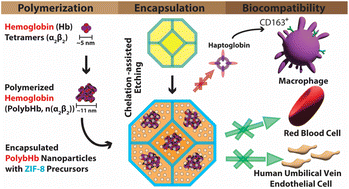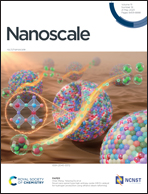ZIF-8 metal organic framework nanoparticle loaded with tense quaternary state polymerized bovine hemoglobin: potential red blood cell substitute with antioxidant properties
Abstract
Due to several limitations associated with blood transfusion, such as the relatively short shelf life of stored blood, low risk of developing acute immune hemolytic reactions and graft-versus-host disease, many strategies have been developed to synthesize hemoglobin-based oxygen carriers (HBOCs) as universal red blood cell (RBC) substitutes. Recently, zeolite imidazole framework-8 (ZIF-8), a metal–organic framework, has attracted considerable attention as a protective scaffold for encapsulation of hemoglobin (Hb). Despite the exceptional thermal and chemical stability of ZIF-8, the major impediments to implementing ZIF-8 for Hb encapsulation are the structural distortions associated with loading large quantities of Hb in the scaffold as the Hb molecule has a larger hydrodynamic diameter than the pore size of ZIF-8. Therefore to reduce the structural distortion caused by Hb encapsulation, we established and optimized a continuous-injection method to synthesize nanoparticle (NP) encapsulated polymerized bovine Hb (PolybHb) using ZIF-8 precursors (ZIF-8P-PolybHb NPs). The synthesis method was further modified by adding EDTA as a chelating agent, which reduced the ZIF-8P-PolybHb NP size to <300 nm. ZIF-8P-PolybHb NPs exhibited lower oxygen affinity (36.4 ± 3.2 mm Hg) compared to unmodified bovine Hb, but was similar in magnitude to unencapsulated PolybHb. The use of the chemical cross-linker glutaraldehyde to polymerize bovine Hb resulted in the low Hill coefficient of PolybHb, indicating loss of Hb's oxygen binding cooperativity, which could be a limitation when using PolybHb as an oxygen carrier for encapsulation inside the ZIF-8 matrix. ZIF-8P-PolybHb NPs exhibited slower oxygen offloading kinetics compared to unencapsulated PolybHb, demonstrating successful encapsulation of PolybHb. ZIF-8P-PolybHb NPs also exhibited favorable antioxidant properties when exposed to H2O2. Incorporation of PolybHb into the ZIF-8 scaffold resulted in reduced cytotoxicity towards human umbilical vein endothelial cells compared to unloaded ZIF-8 NPs and ZIF-8 NPs loaded with bovine Hb. We envisage that such a monodisperse and biocompatible HBOC with low oxygen affinity and antioxidant properties may broaden its use as an RBC substitute.



 Please wait while we load your content...
Please wait while we load your content...